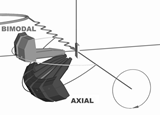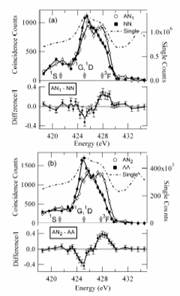|

DEPARTMENT OF PHYSICS AND
ASTRONOMY
LINKS
|

Angle-resolved APECS: Basics
|
 Auger-photoelectron
coincidence spectroscopy enables one to study the Auger or core
level photoelectron spectrum of a solid with unprecedented
discrimination. By performing such measurements in an
angle-resolved mode, one can take advantage of the constraints
placed on the APECS spectrum by the dipole and Coulomb matrix
elements. These measurements, performed at the ALOISA beamline
of the ELETTRA synchrotron in Trieste, Italy, use a versatile
experimental chamber with seven hemispherical electron energy
analyzers, mounted on two independent axes. Typically, two
analyzers are tuned to the kinetic energy of the core level
photoelectrons of interest, while the remaining five analyzers
collect Auger electrons. Thus, ten coincidence pairs are
collected simultaneously. This arrangement compensates in part
for the small solid angle collected by each analyser. Auger-photoelectron
coincidence spectroscopy enables one to study the Auger or core
level photoelectron spectrum of a solid with unprecedented
discrimination. By performing such measurements in an
angle-resolved mode, one can take advantage of the constraints
placed on the APECS spectrum by the dipole and Coulomb matrix
elements. These measurements, performed at the ALOISA beamline
of the ELETTRA synchrotron in Trieste, Italy, use a versatile
experimental chamber with seven hemispherical electron energy
analyzers, mounted on two independent axes. Typically, two
analyzers are tuned to the kinetic energy of the core level
photoelectrons of interest, while the remaining five analyzers
collect Auger electrons. Thus, ten coincidence pairs are
collected simultaneously. This arrangement compensates in part
for the small solid angle collected by each analyser. |
AR-APECS: Recent Highlight
Dichroic Effect in Angle Resolved- (DEAR-) APECS:
The polarization vector of the linearly polarized synchrotron radiation
establishes a quantization axis for the photoexcitation process.
This constrains the l and m quantum numbers of the core hole that
forms the initial state of the Auger transition. Similar, but
more complicated, constraints
arising from the Coulomb matrix
element of the Auger transition results in further restriction of
the possible values of the quantum numbers of the two holes in the
Auger final state. When the two holes have the same principle
quantum number, as in the Sn L23M45M45
Auger transition shown in the figure at the left, one can choose a
geometry so that all of the spatial quantum numbers of the two holes
are identical. Then the Pauli exclusion principle demands that
the holes have opposite spin.
In this way, the singlet final states will dominate the spectrum.
This is shown in the "NN" and "AA" curves in figures (a) and (b) at
the left. Similarly, other geometries suppress the singlet states and enhance
the triplet states. This behavior is demonstrated by the AN
curves in the Figure. By calculating the difference spectra
(AN-NN) or (AN-AA), a geometrically induced dichroic effect in angle
resolved APECS (DEAR-APECS) is observed. This effect can
be used to explore magnetic behavior in complicated systems in an
element specific manner.
polarization vector of the linearly polarized synchrotron radiation
establishes a quantization axis for the photoexcitation process.
This constrains the l and m quantum numbers of the core hole that
forms the initial state of the Auger transition. Similar, but
more complicated, constraints
arising from the Coulomb matrix
element of the Auger transition results in further restriction of
the possible values of the quantum numbers of the two holes in the
Auger final state. When the two holes have the same principle
quantum number, as in the Sn L23M45M45
Auger transition shown in the figure at the left, one can choose a
geometry so that all of the spatial quantum numbers of the two holes
are identical. Then the Pauli exclusion principle demands that
the holes have opposite spin.
In this way, the singlet final states will dominate the spectrum.
This is shown in the "NN" and "AA" curves in figures (a) and (b) at
the left. Similarly, other geometries suppress the singlet states and enhance
the triplet states. This behavior is demonstrated by the AN
curves in the Figure. By calculating the difference spectra
(AN-NN) or (AN-AA), a geometrically induced dichroic effect in angle
resolved APECS (DEAR-APECS) is observed. This effect can
be used to explore magnetic behavior in complicated systems in an
element specific manner.
Read more:
Dichroic effects in Auger photoelectron coincidence spectroscopy
of solids
R. Gotter, F. Da Pieve, A. Ruocco,
F. Offi, G. Stefani, and R.A. Bartynski, Phys. Rev. B 72,
235409 (2005)
|
Recent Publications
(back to top)
-
Room temperature ferromagnetism in Mn ion
implanted epitaxial ZnO films
D.H.Hill, D.A. Arena,
R.A. Bartynski, P. Wu, G. Saraf, Y. Lu, L. Wielunski, R. Gateau, J.
Dvorak, A. Moodenbaugh, and Y.K. Yeo, Physica Status Solidi A,
203, 3836 (2006)
-
Ferromagnetism in Fe-implanted a-plane ZnO
Films
D.P. Wu, G. Saraf, Y. Lu, D.H. Hill, D.A. Arena, R.A. Bartynski, L.
Wielunski, R. Gateau, J. Dvorak, A. Moodenbaugh, T. Siegrist, J.
A. Raley, and Yung Kee Yeo, Appl. Phys. Lett.89, 12508
(2006)
-
The relation between crystalline phase,
electronic structure, and dielectric properties in high-k gate
stacks
S.
Sayan, M. Croft, N.C. Nguyen, T. Emge, J. Ehrstein, I. Levin, J.
Suehle, R.A. Bartynski, and E. Garfunkel, AIP Conf. Proc. 788,
92 (2005)
-
Dichroic effects in Auger-photoelectron
coincidence spectroscopy of solids
R.
Gotter, F. Da Pieve. A. Ruocco, F. Offi, G. Stefani, R.A.
Bartynski, Phys. Rev. B. 72, 235409 (2005)
-
Inverse Photoemission Spectroscopy from
Al(100)
J. F. Veyan, W. Ibanez, R.A.
Bartynski, P Vargas, and P. Haberle, Phys. Rev. B. 71,
155416 (2005)
|
|